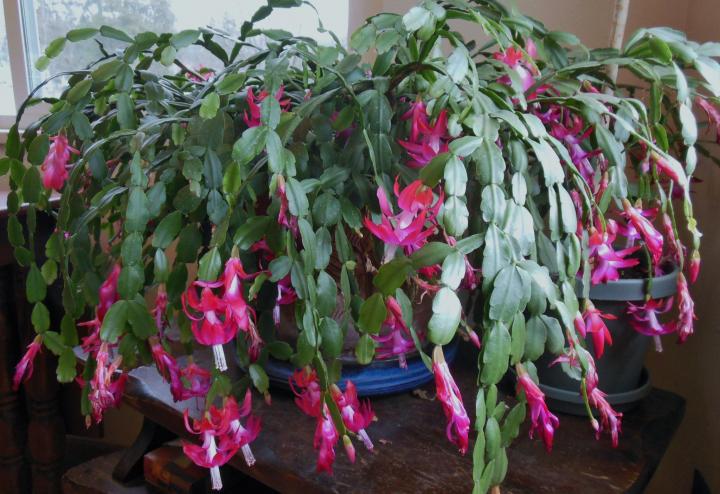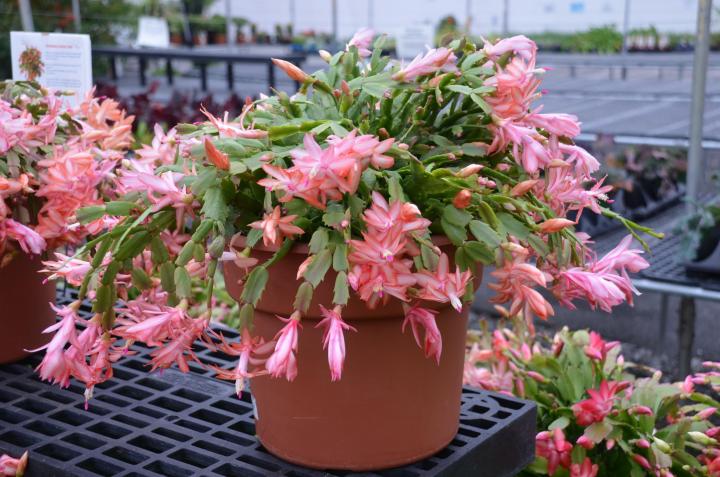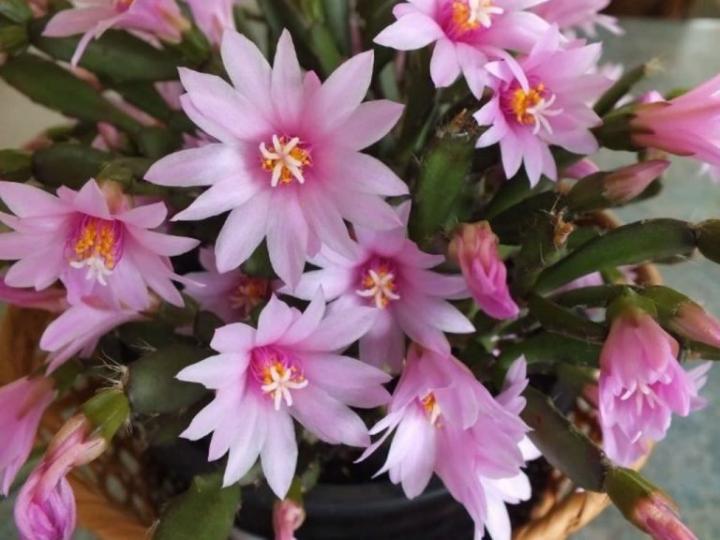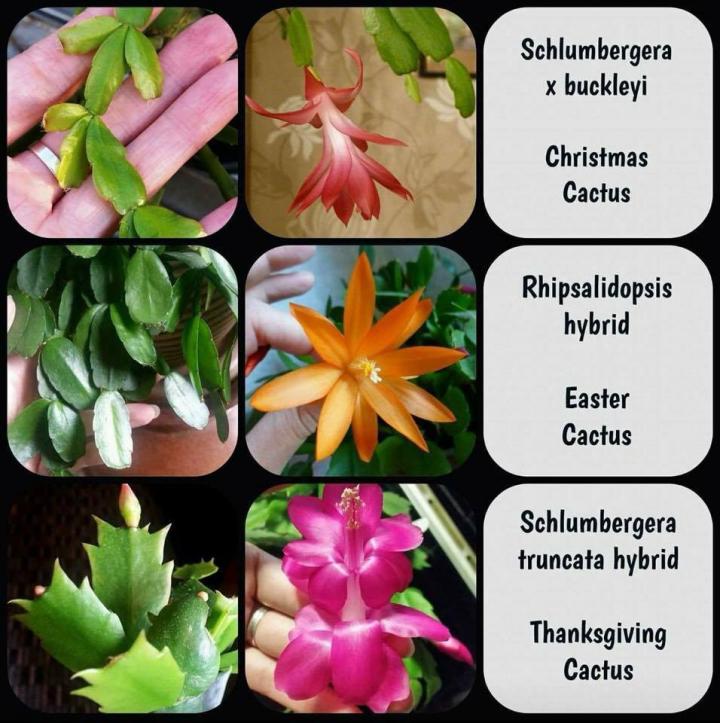Christmas Cactus Versus Thanksgiving Cactus Versus Easter Cactus
Did you know that there are Easter, Thanksgiving, AND Christmas cacti? How can you tell the difference among these holiday cacti? Find out with these helpful pictures!
Holiday cacti such as the Christmas cactus, Thanksgiving cactus, and Easter cactus are all hybrids of Brazilian forest cacti.
- Thanksgiving and Christmas cacti are members of the genus Schlumbergera.
- Easter cactus is in the genus Rhipsalidopsis, which grows in drier forests.
The holiday designations reflect when the different cacti bloom in North America.
Read Next
Let’s look at when the flowers bloom, the way the flower blooms, and the shape of the stems and leaves.
Christmas Cactus
Christmas cactus (Schlumbergera bridgesii) is the long-lived plant our grandmothers grew. I have a plant that came from one my mother-in-law grew from a cutting she received over 70 years ago! They are the ultimate pass-along plant since they are so easy to root. Just pinch off a “Y” shaped piece from one of the branches and stick it in a pot of sterile soil or vermiculite. It will root in no time.

Thanksgiving Cactus
Thanksgiving cactus (Schlumbergera truncata) typically blooms between mid-November and late December, sometimes through January. Its leaf segments are square-shaped with pointed hooks on one end and pincer-shaped along the sides, giving rise to its common name, “crab cactus.” It is native to Brazil, where its 2- to 3-inch–long flowers are pollinated by hummingbirds.

Easter Cactus
If you find that your holiday cactus has spring flowers, it may very well be an Easter cactus (Rhipsalidopsis gaertneri), which blooms in late winter and spring, often from March until May.
Also called a “Spring Cactus,” the Easter cactus has flared, trumpet-shaped flowers with pointy petals, which are usually pink, but can also come in red, orange, and other cherry colors. Their star-shaped petals open at sunrise and close at sunset, lasting for several weeks. They bear flat, succulent leaf segments.

More Ways to Tell a Christmas Cactus from a Thanksgiving Cactus
Many of the available plants are hybrid crosses of Christmas and Thanksgiving cacti, such as S. x buckleyi (a hybrid of S. russelliana x S. truncata), and come in a rainbow of exotic colors, including orange, purple, yellow, red, pink, white, and two-tones.
Look at their bloom color and the way the flower blooms:
- The Christmas cactus has hanging flowers in shades of magenta and blooms, of course, near Christmas. The flowering range is late November through early February.
- The Thanksgiving cactus has flowers that face outwards, and the plant comes in various colors. This plant blooms nearer to Thanksgiving than the Christmas cactus. It can start flowering in very late October or in November.
They also have different stems:
- The true Christmas cactus has a flattened stem segment with smooth, scalloped edges.
- The Thanksgiving cactus has a very toothy stem with two to four pointed teeth.
- While the Christmas cactus stems hang down like a pendant, the Thanksgiving cactus has stems that grow upright at first and then arch.
Most nurseries and stores actually sell the Thanksgiving cactus (not the Christmas cactus) because it blooms around American Thanksgiving. The Christmas cactus is also more difficult to ship as the stems are more fragile and often break.

Caring For Your Holiday Cactus
The holiday cactus is not your typical cactus. We are all familiar with the desert cactus, but the holiday plant is a forest cactus—an epiphyte that lives in decomposing leaf litter found in the forks and on the branches of trees in tropical rainforests of South America.
- The conditions in our houses are nothing like their native rainforest homes, but still, they do fine in normal household temperatures of 65–70°F, with a drop at night to 55–60°F. They will need protection when temperatures drop below 40°F.
- They like their forest floor, so give acidic, well-draining soils to these cacti. Use a cactus mix and add perlite, vermiculite, and orchid bark.
- They like bright light but not direct sun; an east or west window is perfect. If the leaves turn yellow, it means they are getting too much light. If put outdoors in the warmer months, keep them under a shade tree or patio. Not in full sun.
- Let the plants dry out between waterings by watering them when the top 2 inches of the soil feels dry. Do not overwater; this is the number one reason for their demise in our homes. Neglect is better than overwatering! You could get a hydrometer to help you know when to water. Don’t let them sit in water because they will rot if they get too waterlogged!
- Misting the plants frequently helps increase humidity.
- Optional: Fertilize them with an all-purpose fertilizer such as a Miracle Grow Tomato water-soluble fertilizer (1 tablespoon to a gallon of non-chlorinated water). Feed two times a month while the plant is actively growing (usually spring and summer).
How to Keep Holiday Cactus Blooming
Short days and cool nights are the keys to getting your holiday cactus to blossom. They need 13 hours of darkness and nights at 50–55°F for at least 1 to 2 months before they will set buds. I put some of my plants outside all summer and wait until the nights drop below 50°F before bringing them in for the fall and winter. They usually bud right up and start to bloom after that. The plants that grow in my kitchen get no special treatment and blossom just as well. Go figure!
The plants flower best when slightly potbound, so only repot them if they are really crowded. Unlike many holiday plants, they are nontoxic to cats and dogs, so don’t be afraid to bring one home for the holidays!
Read more about plant care tips on our Christmas Cactus Growing Guide.
